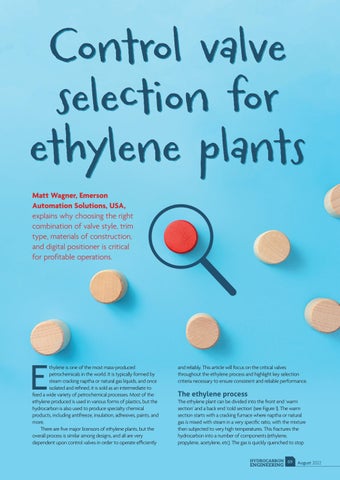Matt Wagner, Emerson Automation Solutions, USA, explains why choosing the right combination of valve style, trim type, materials of construction, and digital positioner is critical for profitable operations.
E
thylene is one of the most mass-produced petrochemicals in the world. It is typically formed by steam cracking naptha or natural gas liquids, and once isolated and refined, it is sold as an intermediate to feed a wide variety of petrochemical processes. Most of the ethylene produced is used in various forms of plastics, but the hydrocarbon is also used to produce specialty chemical products, including antifreeze, insulation, adhesives, paints, and more. There are five major licensors of ethylene plants, but the overall process is similar among designs, and all are very dependent upon control valves in order to operate efficiently
and reliably. This article will focus on the critical valves throughout the ethylene process and highlight key selection criteria necessary to ensure consistent and reliable performance.
The ethylene process The ethylene plant can be divided into the front end ‘warm section’ and a back end ‘cold section’ (see Figure 1). The warm section starts with a cracking furnace where naptha or natural gas is mixed with steam in a very specific ratio, with the mixture then subjected to very high temperatures. This fractures the hydrocarbon into a number of components (ethylene, propylene, acetylene, etc). The gas is quickly quenched to stop HYDROCARBON 69
ENGINEERING
August 2022
